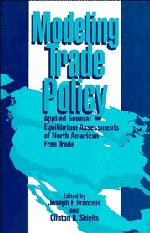1 - AGE Models of North American Free Trade
Published online by Cambridge University Press: 25 March 2010
Summary
The North American Free Trade Agreement (NAFTA) has been the subject of a protracted and acrimonious public debate in the United States about its overall economic benefits as well as its impact on labor and the environment. In the context of this debate, applied general equilibrium (AGE) models of trade liberalization between Canada, Mexico, and the United States have emerged as the tools of choice for analyzing NAFTA.
The NAFTA debate has provided a common focus for economists working on AGE modeling of trade policy. As this volume went to press, the final outcome of the debate and the fate of the NAFTA agreement had not been resolved; regardless of the outcome, however, the essays collected in this volume provide a unique opportunity to assess, in the context of a closely related set of policy experiments, the current status and direction of research on AGE modeling of trade policy. The chapters reflect both the sometimes impressive progress made to date in AGE modeling and the significant shortcomings of the current generation of models.
Background
Compared to the enactment of the U.S.-Canada Free Trade Agreement (CAFTA), the movement toward trade liberalization between Mexico and its North American neighbors has been relatively rapid. As recently as 1990, many analysts viewed the prospect of a U.S.-Mexico free trade area as having little chance of passage in either country.
- Type
- Chapter
- Information
- Modeling Trade PolicyApplied General Equilibrium Assessments of North American Free Trade, pp. 3 - 44Publisher: Cambridge University PressPrint publication year: 1994
- 12
- Cited by



